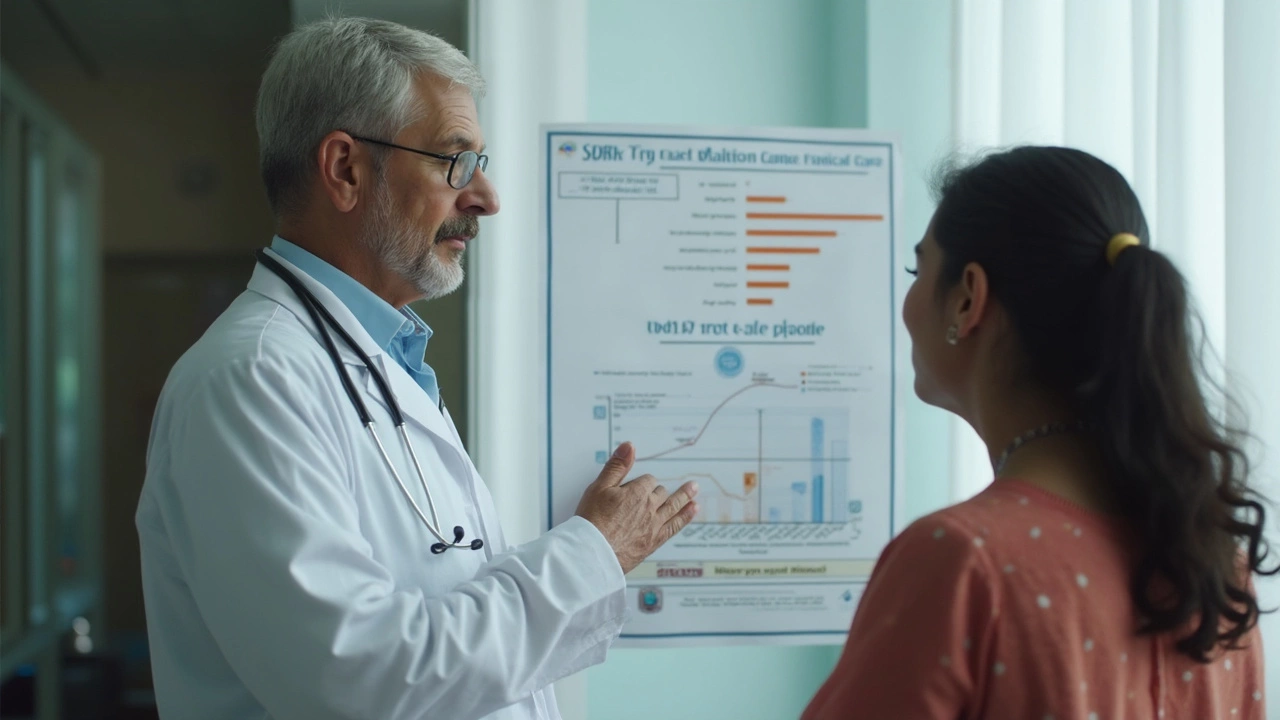If you told someone there's such a thing as an "easiest cancer to fight," most folks would look surprised. But it's true. Not every cancer spells disaster. Some are caught early, grow slow, and respond amazingly well to treatment. When people ask doctors about the most beatable cancer, thyroid cancer nearly always tops the list. It's not about downplaying the risk—it's about knowing what you’re up against, and where modern medicine is winning.
A huge reason survival rates are so high for thyroid cancer? Most cases show up early, sometimes as just a small lump you can actually feel. Doctors spot it pretty quickly during routine physicals or even by accident on other scans. Plus, treatment is usually straightforward, with surgery or a small radioactive pill often doing the trick. The numbers don’t lie—over 95% of people with the most common types of thyroid cancer keep living normal lives. That's not just hope talking, that’s hard data backing it up.
- What Makes a Cancer 'Easy' to Fight?
- Thyroid Cancer: The Standout Survivor
- Other Cancers with High Cure Rates
- Early Detection: Why It Works
- Treatment Options That Work Best
- Everyday Steps to Boost Your Odds
What Makes a Cancer 'Easy' to Fight?
Not every cancer reacts the same way when it’s found. Some, like thyroid cancer, are easier to handle because of key reasons experts agree on. When people talk about the easiest cancer to fight, here’s what usually puts it at the top of the list:
- Early detection: Cancers that show up with obvious symptoms or get flagged on routine health checks give you a head start. Catching it early often means a simpler, shorter treatment plan.
- Slow growth: Certain cancers grow so slowly you can spot them before they do serious damage. This makes them more manageable and less likely to spread.
- Effective treatment options: Easy-to-fight cancers usually have proven treatments that work for most people. Surgery, targeted therapy, and even mild radiation can knock them out.
- High survival rates: If most folks beat the cancer and get back to a healthy life, it gets called “easy” to fight, at least compared to tougher ones like pancreatic or lung cancer.
A great example, according to the American Cancer Society, is papillary thyroid cancer. As they put it:
"The 5-year survival rate for papillary thyroid cancer, the most common type, is almost 100% if it’s caught early."
Look at the numbers for common high-survival cancers:
| Cancer Type | 5-Year Survival Rate (Localized) |
|---|---|
| Thyroid | 98-100% |
| Testicular | 95-99% |
| Prostate | 99% |
The bottom line: For a cancer to be called “easy to fight,” doctors look at how soon you can find it, how fast it moves, and if the treatments really work. That’s why not all cancers are the same—even the word “cancer” covers hundreds of different illnesses.
Thyroid Cancer: The Standout Survivor
If you’re going to get cancer (not that anyone wants one), thyroid cancer is pretty much the textbook example of an "easy" cancer to fight. It sits right at the top because treatment methods are straightforward, and most people walk away with a good outcome. The numbers back this up big time: the 5-year survival rate for the most common type—papillary thyroid cancer—is 98% if caught early.
One thing that makes thyroid cancer so beatable is how slow it grows. Unlike super aggressive cancers, this one usually stays local and rarely spreads until very late. Doctors usually spot a lump in the neck, do a quick ultrasound, and confirm things with a simple biopsy. Sometimes, you find it totally by accident when getting scanned for something else. That’s a lucky break most folks would never expect.
Treatment? Most times, it’s just surgery to remove part or all of the thyroid. A lot of people then take a radioactive iodine pill to zap any leftover cancer cells. No long chemo marathons or endless hospital stays. And guess what? You’ll just need to take a daily thyroid pill afterward—easy routine, no drama.
Here’s a quick look at survival stats from real data that show why thyroid cancer easily tops the list as the easiest cancer to fight:
| Type | Stage 1-2 5-Year Survival | Stage 3-4 5-Year Survival |
|---|---|---|
| Papillary | 99% | 76-93% |
| Follicular | 98% | 63-94% |
Doctors also keep a close eye on things with regular check ups, but most people don’t need anything beyond surgery and that one pill. Tips for stacking the odds in your favor? Go to regular checkups, know your family history, and pay attention to any weird lump in your neck or throat. Caught early, thyroid cancer is about as close as you get to a "good" cancer, in a world where none of them are truly good.
Other Cancers with High Cure Rates
When people talk about the easiest cancer to fight, thyroid cancer gets the spotlight, but it’s definitely not alone. A few other cancers are known for being highly treatable, especially if you catch them early. Let’s get straight to the point—these cancers aren’t a walk in the park, but their odds are way better than most folks realize.
Testicular cancer scares a lot of younger guys, but it’s actually one of the most curable cancers out there. Over 95% of men with testicular cancer survive at least five years after diagnosis. And with early treatment, that number climbs even higher. One big reason? Doctors usually find this cancer early, and it responds super well to surgery and, when needed, chemo.
Prostate cancer is another big one. More guys get prostate cancer than almost any other kind, but thanks to regular screenings and slow growth, the survival rate is about 98% after five years, especially if it’s found before it spreads.
Skin cancer—at least the common types like basal cell and squamous cell carcinoma—also has high cure rates with simple treatments, like a quick removal in the doctor’s office. Melanoma is the more dangerous skin cancer, but if it’s caught early, treatment success is over 99%.
| Cancer Type | 5-Year Survival Rate | Key to Success |
|---|---|---|
| Thyroid | 98% | Early detection, effective treatment |
| Testicular | 95% | Quick diagnosis, responsive to chemo & surgery |
| Prostate | 98% | Screenings, slow growth of cancer cells |
| Skin (early melanoma) | 99% | Visual checks, simple procedures |
If you or someone you know is facing one of these, there’s a ton of reason to feel positive. The key takeaway is that with the right info, regular checks, and smart action, these cancers are way less scary than they sound.

Early Detection: Why It Works
Spotting cancer early is a game-changer. For something like thyroid cancer, catching it before it spreads makes treatment way simpler and way more successful. When you grab a problem in the early stages, doctors have more options, and the body has less damage to heal from. Sounds basic, right? But it actually saves lives.
Here’s the plain truth: thyroid lumps don't usually cause pain, so most people don’t notice them until a doctor pokes around or a routine scan picks it up. Huge studies, like one from the American Cancer Society, found over 70% of folks with thyroid cancer were diagnosed at stage I, when the tumor is small and hasn't spread. That matters—a ton.
| Stage at Detection | 5-Year Survival Rate |
|---|---|
| Stage I (local) | 98% |
| Stage II (nearby tissues) | 95% |
| Stage IV (spread far) | 51% |
So why does early detection make such a difference? Here's what it really does for you:
- Makes treatment less intense—often just surgery, not endless cycles of chemo.
- Bumps up your chances of being totally cancer-free for good.
- Gives you more choices, like whether you even need radioactive therapy at all.
- Lowers the chance the cancer will come back later.
It's not just about luck. You can make early detection work for you. Stay on top of regular check-ups, especially if you have a family history or weird new lumps. As Dr. Michael Tuttle from Memorial Sloan Kettering says,
“The earlier we find thyroid cancer, the better the outcome. That’s why routine physicals and not ignoring little neck bumps matter so much.”
Keeping an eye out truly changes the story with easiest cancer to fight types like thyroid cancer. No magic, just smart checks and quick action.
Treatment Options That Work Best
If you’re looking for practical info about the easiest cancer to fight, you probably want the lowdown on treatment options that actually deliver. For thyroid cancer, the battle plan is usually pretty straightforward and has solid results. Here’s what most people go through and why these treatments work so well, especially compared to tougher cancers.
The first step for a lot of patients is surgery. Doctors usually remove part or all of the thyroid, depending on the lump’s size and spread. Tons of folks worry about surgery, but for the most common types of thyroid cancer, it’s usually enough. You can be back to work or your normal routine pretty soon. If the whole thyroid comes out, you'll just need to take a daily pill (thyroid hormone) for life. Honestly, most people get used to this pretty fast.
Another big gun is radioactive iodine therapy. Think of it as a targeted clean-up crew. This treatment wipes out any tiny leftover cancer cells without messing up the rest of your body. Most folks just swallow a capsule and go home after a few days. Side effects are way milder than chemo for other cancers – think minor tiredness or a sore throat, not hair loss and weeks of nausea.
- Surgery: Removes the whole or part of the thyroid. Quick recovery for most. Needed for early and advanced stages.
- Radioactive Iodine: Swallowed as a pill. Targets leftover cells. Minimal downtime.
- External Radiation: Rarely used for thyroid cancer but available for tougher cases.
- Targeted Therapy and Chemo: Only for rare, tough-to-treat types or cancers that spread.
Here's a handy table that breaks down how often these treatments work for thyroid cancer, one of the cancers with high cure rates:
| Treatment | Used For | Success Rate |
|---|---|---|
| Surgery | Most cases, especially early | 95%+ long-term survival |
| Radioactive Iodine | When needed after surgery | Almost as high |
| External Radiation | Rare, advanced cases | Varies, but less common |
| Chemo/Targeted Therapy | Only rare, aggressive types | Much lower, but improving |
One smart tip? Team up with a doctor or cancer care team that’s seen lots of these cases. The most beatable cancers usually have clear treatment pathways, and experienced teams know when to go big and when to keep it simple. That expert advice really pays off, especially when navigating your options for the easiest cancer to fight.
Everyday Steps to Boost Your Odds
You don't need to overhaul your entire life to help your body fight cancer more effectively. You just need smart habits and a little consistency. These practical moves can up your survival game, especially when dealing with the easiest cancer to fight, like thyroid cancer or skin cancer.
- Don’t skip doctor check-ups: Regular exams and blood tests make a real difference. If something new pops up—a lump, swelling, weird symptoms—bring it up right away. Early detection is huge for high cancer survival rates.
- Know your family’s history: Some thyroid and other cancers run in families. If anyone in your family has had thyroid cancer, let your doctor know. They may suggest extra checks or thyroid screenings.
- Eat well and stay active: A balanced diet with lots of fruit, veggies, lean protein, and fiber gives your body what it needs. Regular exercise—think brisk walking for 30 minutes—keeps your immune system in shape. For people with thyroid cancer, keeping a healthy weight helps manage hormone levels.
- Mind your meds and supplements: If you’re on thyroid meds after surgery, take them every day as instructed. This keeps your body running smoothly. Double-check with your doctor about any supplements—some can mess with your treatment.
- Protect your neck from radiation: If you work in healthcare or dental fields, always use protection shields around your neck during x-rays. Too much radiation boosts thyroid cancer risk.
- Quit smoking and watch your alcohol: Both are linked to several cancers and bad outcomes. Ditching the smokes and cutting back on drinking improves your odds across the board.
- Stick to follow-up care: It’s tempting to skip post-treatment scans when you feel fine, but sticking to the plan helps spot recurrences while they’re still easy to manage.
Check out how these basic steps make an impact. Here’s something eye-opening:
| Action | Improvement in Outcomes |
|---|---|
| Early detection (stage 1 vs. stage 4) | Up to 98% vs. 15% five-year survival rate (thyroid cancer) |
| Quitting smoking | Reduces overall cancer risk by 30% after 5 years |
| Regular follow-up care | Catches 85% of recurrences early for best treatment |
These are moves everyone can make, and they're especially effective for folks dealing with the easiest cancer to fight. It’s about stacking small wins. You don’t have to be perfect. Just keep at it, and your chances get better every step of the way.





